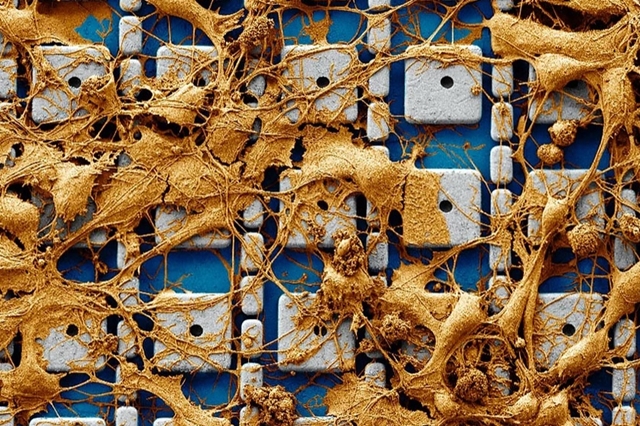
Scanning electron microscope image of neurons cultured on top of the electrode array (Donhee Ham Lab, Harvard University)
28 Apr. 2022. A drug discovery company with an electronic screening process based on semiconductor technology is starting up and raising $9.25 million in seed funds. CytoTronics, in Boston, licenses advances in biomedical engineering, chemistry, and quantum physics from the labs of its scientific founders at Harvard University.
CytoTronics is creating a complementary metal-oxide-semiconductor, or CMOS, platform for drug discovery. CMOS is the technology used in today’s semiconductor chips that the company says it applies to measure activity and manipulate live cells. CytoTronics is based on research in the labs of its scientific founders, engineering professor Donhee Ham, and professor chemistry and physics Hongkun Park, both at Harvard University.
Donhee Ham and colleagues study properties of CMOS technology applied to the study of live cells, particularly neurons or nerve cells. In 2019, the lab demonstrated a nanoscale electrode array that performs large-scale parallel intracellular recordings of neurons in mammals, a technology that until then was considered difficult to achieve. Hongkun Park’s lab studies characteristics of nanoscale devices based on quantum physics that interface with living cells and organisms. In a paper published earlier this year, Ham and Park show how CMOS micro-electronic arrays are applied to several biomedical functions including measurements of metabolic state and wound healing.
CytoTronics says its CMOS-based technology reduces the time and complexity of characterizing and visualizing cell activity, down to individual cells. This process, says the company, makes it possible to create images of cell activity without time-consuming intermediate steps like adding fluorescent markers, and at higher resolutions than current technologies. And CytoTronics says its systems can readily connect to other electronic devices for data collection and processing.
Develop discoveries through preclinical stages
While CytoTronics has not revealed specific drug discovery targets, it notes the company’s technology can visualize the metabolic state of cells to reveal oxidative stress, antioxidant capacity, and cell-death mechanisms. In addition, Cytotronics says it can apply the technology to measure wound healing, and track responses to excitable cells, such as neurons and heart tissue cells. The company plans to develop its discoveries through preclinical stages.
The company officially founded in 2020, but started operations in last year. Jeffrey Abbott, a graduate student and postdoctoral researcher in both Ham’s and Park’s labs, co-founded Cytotronics with Vince Wu, a veteran of Ham’s lab. Abbot and Wu, co-authors on both papers, are the company’s CEO and chief technology officer respectively. Duane Sword, chief business officer, is also a co-founder. The company’s offices, as well as wet and electronic labs, are located in the Agility Labs life science incubator in Boston.
“Our technology,” says Wu in a company statement released through BusinessWire, “will enable scientists and researchers to capture highly valuable image-based information from cells in real-time and in high-throughput, which will potentially revolutionize early-stage drug-discovery process in multiple areas such as oncology, gastroenterology, cardiology, and neurology.”
“We are targeting the roughly $20 billion low-throughput cell-based assay market with the CytoTronics platform,” notes Abbott, “and plan to quickly progress to higher-throughputs, in short making drug discovery research more precise, automatic, repeatable, and scalable.”
CytoTronics is raising $9.25 million in seed funds, led by life science investor Anzu Partners in Washington, D.C., with Milad Alucozai, an early-stage technology entrepreneur and advisor taking part.
More from Science & Enterprise:
- Synthetic Bio Companies Partner on Therapeutic Microbes
- Drug Discovery Biotech Inks Partnering Deal, Gains $175M
- Start-Up Designs RNA Drugs on Demand, Raises $40M
- Challenge Seeks A.I. Antibody Enhancement Platform
- Start-Ups Partner on Quantum Computing and Longevity
We designed Science & Enterprise for busy readers including investors, researchers, entrepreneurs, and students. Except for a narrow cookies and privacy strip for first-time visitors, we have no pop-ups blocking the page, nor distracting animated GIF graphics. If you want to subscribe for daily email alerts, you can do that here, or find the link in the upper left-hand corner of the desktop page. The site is free, with no paywall. But, of course, donations are gratefully accepted.
* * *

 RSS - Posts
RSS - Posts
[…] Semiconductor Tech Drug Discovery Company Underway […]